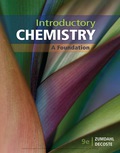
Concept explainers
. Write the formula for the missing reactant or product in each of the following chemical equations.
a.
c.
Trending nowThis is a popular solution!

Chapter 20 Solutions
Introductory Chemistry: A Foundation
Additional Science Textbook Solutions
Organic Chemistry As a Second Language: Second Semester Topics
Chemistry: The Molecular Nature of Matter
Organic Chemistry (9th Edition)
Chemistry: Atoms First
Chemistry: Matter and Change
Thermodynamics, Statistical Thermodynamics, & Kinetics
- Complete and balance the following combustion reactions. Assume that each hydrocarbon is converted completely to carbon dioxide and water. (a) Propane + O2 (b) Octane + O2 (c) Cyclohexane + O2 (d) 2-Methylpentane + O2arrow_forwardAlcohols are very useful starting materials for the production of many different compounds. The following conversions, starting with 1-butanol, can be carried out in two or more steps. Show the steps (reactants/catalysts) you would follow to carry out the conversions, drawing the formula for the organic product in each step. For each step, a major product must be produced. (See Exercise 62.) (Hint: In the presence of H+, an alcohol is converted into an alkene and water. This is the exact reverse of the reaction of adding water to an alkene to form an alcohol.) a. 1-butanol butane b. 1-butanol 2-butanonearrow_forward12. At most service stations, patrons can select their grade of gasoline. The different grades of gasoline are classified based on the octane rating of each fuel. From a chemical point of view, analyze the significance of octane ratings in the fuel industry. Be sure to cite your sources! Hint: Refer to page 392 in your textbook Your response should include an explanation of octane numbers a discussion of the importance of octane rating identifying how the octane rating of a fuel is adjustedarrow_forward
- Write a balanced chemical equation for the reaction of ethene with oxygen. O a. C2H4(g) + 302(g) → 2CO2(g) + 2H2O(g) O b. 2C2H2(g) + 502(g) → 4CO2(g) + 2H2O(g) O c. CH4(g) + 2O2(g) → CO2(g) + 2H2O(g) O d. C2H4(g) + 202(g) → 2CO2(g) + 2H2(g) O e. 2C2H6(g) + 702(g) →> 4CO2(g) + 6H2O(g)arrow_forwardVI. Name the following hydrocarbons. CH, H3c Br 1. CH3 CH3 2. Hac CH3 3.arrow_forward47. Which compound is most likely to be found in your gas tank? A. C5H12 B. C8H18 C. dimethyl ethane D. ethyl propyl ethane E. C6H12arrow_forward
- Match the name with the chemical formula or structural diagram. H₂C T CH OH I OH H₂C HO CH₂ CH₂ CH CH₂ OH H₂C H₂C H₂C CH₂ CH₂ OH OH T CH₂ CH OH CH3 H3C-CH₂-OH CH L. CH3 CH₂ OH CH3 CH₂ CH₂ CH3 1. ethanol 2. propan-1-ol 3. butane-1,2-diol 4. 3-ethyl-4-methyloctan-1-ol 5. 2,3-dimethylcyclopentanol 6. propane-1,2,3-triolarrow_forward12. Match the name to the organic compound 1 H CEC -H A. ethane B. ethene H-C-C H. C. ethyne H-C-C OH H H нн D. ethanal Н-С-С-О-С-С-н H H нн нн E. ethanoic acid H-C-C-H H H H. F. ethanone 6. C=C H. H. G. diethyl ether H. ethanol H. HICIHHI 2. 3.arrow_forwarda. Give all the structural isomers of the hydrocarbons C5H12.(Hint: 3 isomers) b. Give all the structural isomers of the compound C3H5Cl which contains one C=C bond. (Hint: 3 isomers) c. One of the structural isomers in part b shows cis-trans isomerism. Draw and name this pair of isomers.arrow_forward
- 'N -I H 1. LiAlH4, ether 2. H2Oarrow_forwardHO 1. LAH 2. H₂O* e.arrow_forwardEight organic oxygen compounds are shown below. Select the correct functional group by matching the corresponding roman numeral (I, II, III, etc.) with the correct name.II- a. phenolb. aldehydec. ketoned. 1 alcohole. carboxylic acidf. 3 alcoholg. 2 alcoholh. esterIV-a. phenolb. aldehydec. ketoned. 1 alcohole. carboxylic acidf. 3 alcoholg. 2 alcoholh. esterVI-a. phenolb. aldehydec. ketoned. 1 alcohole. carboxylic acidf. 3 alcoholg. 2 alcoholh. esterVIII-a. phenolb. aldehydec. ketoned. 1 alcohole. carboxylic acidf. 3 alcoholg. 2 alcoholh. esterarrow_forward
 Introductory Chemistry: A FoundationChemistryISBN:9781337399425Author:Steven S. Zumdahl, Donald J. DeCostePublisher:Cengage Learning
Introductory Chemistry: A FoundationChemistryISBN:9781337399425Author:Steven S. Zumdahl, Donald J. DeCostePublisher:Cengage Learning Organic ChemistryChemistryISBN:9781305580350Author:William H. Brown, Brent L. Iverson, Eric Anslyn, Christopher S. FootePublisher:Cengage LearningChemistry: Matter and ChangeChemistryISBN:9780078746376Author:Dinah Zike, Laurel Dingrando, Nicholas Hainen, Cheryl WistromPublisher:Glencoe/McGraw-Hill School Pub Co
Organic ChemistryChemistryISBN:9781305580350Author:William H. Brown, Brent L. Iverson, Eric Anslyn, Christopher S. FootePublisher:Cengage LearningChemistry: Matter and ChangeChemistryISBN:9780078746376Author:Dinah Zike, Laurel Dingrando, Nicholas Hainen, Cheryl WistromPublisher:Glencoe/McGraw-Hill School Pub Co Chemistry: The Molecular ScienceChemistryISBN:9781285199047Author:John W. Moore, Conrad L. StanitskiPublisher:Cengage Learning
Chemistry: The Molecular ScienceChemistryISBN:9781285199047Author:John W. Moore, Conrad L. StanitskiPublisher:Cengage Learning Chemistry for Engineering StudentsChemistryISBN:9781337398909Author:Lawrence S. Brown, Tom HolmePublisher:Cengage Learning
Chemistry for Engineering StudentsChemistryISBN:9781337398909Author:Lawrence S. Brown, Tom HolmePublisher:Cengage Learning Chemistry: An Atoms First ApproachChemistryISBN:9781305079243Author:Steven S. Zumdahl, Susan A. ZumdahlPublisher:Cengage Learning
Chemistry: An Atoms First ApproachChemistryISBN:9781305079243Author:Steven S. Zumdahl, Susan A. ZumdahlPublisher:Cengage Learning





